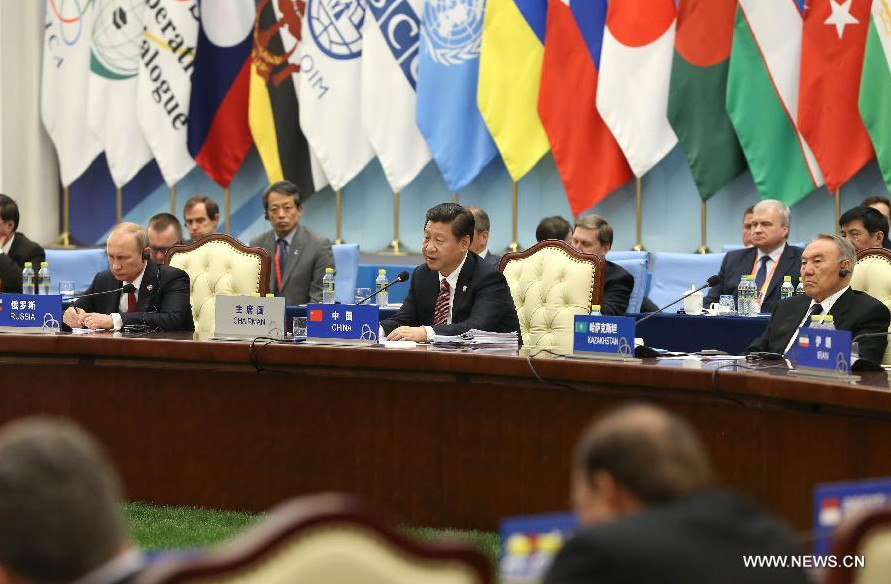
‘Development is the Key to Peace’: Chinese Leaders Discuss Future of Asia
Publication: China Brief Volume: 14 Issue: 10
By:

While tensions in the South China Sea have gone from bad to worse, with riots in Vietnam targeting Chinese businesses and a range of ASEAN states exploring ways to counter Chinese actions (see “Challenged by China, ASEAN States Seek Common Response,” in this issue), Xi’s Wednesday speech at the Shanghai Conference on Interaction and Confidence Building in Asia (CICA) seemed to take place in a different world. Rather than focusing on conflict, he spoke about China’s role in building a “peaceful, stable and cooperative new Asia” (People’s Daily Online, May 21). Xi’s speech called for the construction of a new regional security architecture based on the organization, which China will chair for the next two years.
While recognizing the existence of U.S. interests in Asia, and its right to a role in the region, Xi made it clear that the United States’ current role is far too large. He called upon Asian states to settle their problems “among locals,” dismissed alliances as threatening to regional security and sought to put CICA, an organization which includes Russia and Iran but not the United States, at the center of regional security issues.
Accompanying the speech, official media published a range of articles examining the concept, as well as related ideas such as the “maritime silk road” and the construction of a “Community of Common Destiny” in Asia. Major articles appeared in both Party-oriented media such as Qiushi and People’s Daily, and in externally-oriented outlets such as China International Studies, an English-language journal produced by the Foreign Ministry’s China Institute of International Studies (Qiushi, May 21). The headline story in the latter publication’s current issue, written by Foreign Affairs Vice Minister Liu Zhenmin, is titled “Forging the Asian Community of Common Destiny Together” (China International Studies, March/April 2014).
To outside observers, China’s approach to its neighbors appears to be fundamentally contradictory: Beijing simultaneously puts itself forward as a champion of their security and threatens it with military moves aimed at seizing control of disputed maritime territory, such as November’s announcement of an air defense identification zone covering the East China Sea, and a series of increasingly forceful moves in the South China Sea, most recently the placement of an oil rig near the Paracel Islands, within 200 miles of the coast of mainland Vietnam. These actions appear incompatible with Xi’s account of China’s efforts to build a peaceful and cooperative Asia, and with the push to win friends among Southeast Asian nations announced last year at the work forum on peripheral diplomacy (see China Brief, November 7, 2013). This effort has not been mere words—China has devoted considerable effort and money to establishing new bodies for building infrastructure, promoting cultural exchange and undertaking cooperative efforts like disaster relief.
Xi’s speech, and official articles on Asian community, do not so much respond to this argument as reject its premises: They claim that Asian states are concerned with development above all else, and frame the territorial conflicts as a sideshow. The big top events are trade and economic integration, areas in which China’s rise is clearly positive for the region. Xi, in fact, offered a new definition of security based on this idea: “To the great majority of Asian states, development is the greatest form of security, and it is the overall key to settling regional security issues.”
Analysis in official media has followed this logic even further, either ignoring the current tensions with Vietnam and the Philippines or relegating them to a short paragraph at the end of an article largely dedicated to lauding Asia’s progress toward economic integration. Many of these articles have made explicit comparisons between China’s project and the European Union, comparing the goals of establishing peace and prosperity through integration, while drawing a clear distinction about appropriate institutions.
By this account, China’s strategy for the South China Sea is a facet of a much greater strategy for dealing with Asia—one which calculates that the benefits of trade and development cooperation are so great that they will simply wash out any blowback over its aggressive pursuit of territory. There are very good reasons to be skeptical of this view, especially looking at the concerns increasingly expressed by Southeast Asian states, and the protests and riots against Chinese factories in Vietnam, which suggest a degree of willingness to disrupt trade over territory. Yet Chinese accounts such as Vice Minister Liu’s do argue plausibly that the territorial disputes have hardly slowed the pace of economic integration—regional trade figures with China continue to rise throughout the region. Japan and China, even as their relationship has sunk to its lowest point in decades, have continued to negotiate a three-way free trade agreement with South Korea.
Xi’s confident predictions about the future of Asia may well be wrong. But they do explain the apparent contradiction between China’s efforts to win friends and to win territory, and thus appear to be sincere. If so, they will serve as a basis for decision-making, suggesting that China’s leaders may either not perceive the reputational costs of its territorial disputes, or more likely dismiss them as bound to blow over. We are likely to see more charm offensives and more crises at sea—and to see whether these efforts can in fact be made to coexist.





